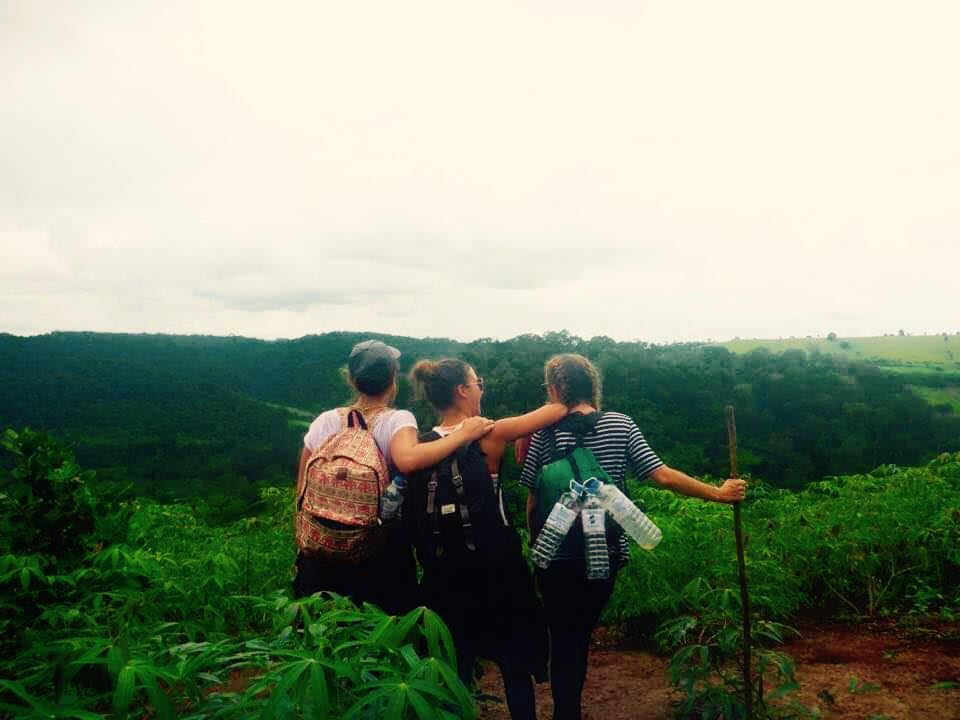
By Dana Di Labio
Pchum Ben falls in September each year, and most Khmer people spend the holiday visiting the temples (wats or pagodas) to honor their ancestors, make offerings, and receive blessings from the monks. We took the opportunity to head to Mondulkiri, a province in North Eastern Cambodia that was a full 10 hour bus ride from our home in Siem Reap. So kindles, ipods and books at the ready, we set off in our 11-seater minibus, ready to face our holiday. Aside from one of us forgetting her shoes (a serious problem when embarking on embarking on a jungle trek!), the journey north to the small town of Sen Monorom was largely uneventful. Although it was dark and quiet, it felt safe and we could see the edges of mountains, jungles and forests.
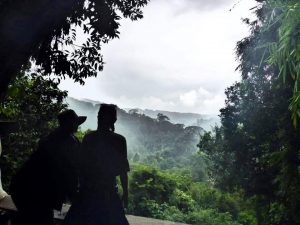
A staff member from Tree Lodge met us and drove us to the hotel in the back of a pick-up truck to the wooden lodge. We were introduced to the couple who run the lodge – Mr. Tree and his wife, who spoke English well, but allowed us to practice our questionable Khmer. After stuffing ourselves with some fried rice and noodles, Mr. Tree led us to our small wooden bungalow – a ‘family room’, which had 3 double beds squashed in together. It felt rustic and cozy; we each had our own mosquito net and a shared hot shower – all for only $15 for the night! (The Lodge also had a supply of leftover shoes we could borrow, which luckily meant no jungle trekking in Birkenstocks!)
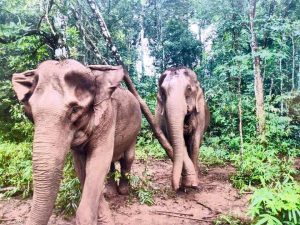
The next morning, bright and early, we headed off with Mr. Tree, and a group of around 20 others. We got into the truck again and drove around 30 minutes to just outside the jungle, where Mr Tree dropped us all off and instructed us to follow the path until we reach the ‘Jungle Lodge’. He drove the car down the hill and into the jungle. A walk of 20 minutes or so brought us up and down a few muddy hills (it was the rainy season after all), to a small wooden hut with canvas sides overlooking the forests and misty rivers. Mr. Tree met us at the hut and introduced The Mondulkiri Project:
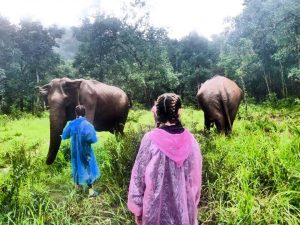
In October 2013 the Mondulkiri Project signed an agreement with Bunong indigenous elders from the Putang Village and the Orang Village. They agreed to end logging in a large area of the beautiful Mondulkiri forest near Sen Monorom, in order protect this beautiful forest and the plentiful wildlife here. As the population of Cambodia grows, the demand for rice also grows, so more and more of the forest is being destroyed to make room for small rice farms. The Elephant Sanctuary experiences and jungle trekking is designed to help to bring income to the Bunang indigenous people while protecting the native habitat of Asian elephants and other endangered species. As part of this agreement, The Mondulkiri Project started an elephant sanctuary with 7 retired elephants who are free to wander through the forest. All of these elephants have been rescued from other provinces, where they were treated unfairly. In the future, Mr. Tree explains, he hopes to start a natural breeding program to help with the long term survival of elephants in Cambodia. Currently the elephants are all female, so the project is trying to raise money to buy a male in order to breed.
After the briefing, we started off into the jungle to meet the elephants. We fed them bananas and learned that there is a trick to doing so – you should hold out 1 banana towards the end of their trunk, while hiding the others behind your back – otherwise the elephants steal the whole bunch! The elephants seemed very at ease around us, and Mr. Tree emphasized that we should let the elephants lead the interaction. After our banana supply had been depleted, we walked back through the rain in our nifty multi colored rain ponchos, across a rickety old bridge. Just as we were crossing, one of the elephants named Princess came bounding through the river and decided to give herself a mud shower. She led the way for us and we followed her into a clearing, where we were joined by several other elephants. We played with them, fed them some more, and marveled at how peaceful they seemed. We headed back to the hut, clad with mud and rain, and sat down for a delicious lunch of rice, vegetables and fish soup. A celebratory beer or two was also a necessity! After a little relaxing, we headed back off into the jungle and down to a river, where we were told we would be able to bathe the elephants. Some of us scrubbed the elephants with long brushes, whilst the others fed them bananas.
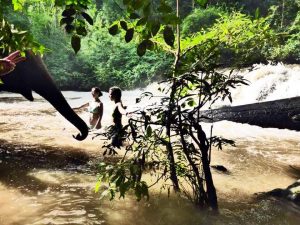
When we returned to the hut for the evening, and were introduced to our guide for the next day – Leung. He and several local Khmer women cooked up a delicious feast for our dinner. We ate on the wooden floor, by candlelight, and spent the evening chatting with Leung. He is from one of the tribal villages, on the other side of the jungle, and he leads the guided treks for the Mondulkiri Project. He told us that we would finish our trek in his village and he explained about his religion – a form of Buddhism that entails ritual animal sacrifice. We played cards, drank bamboo rice wine, and retreated to our hammocks for the night.
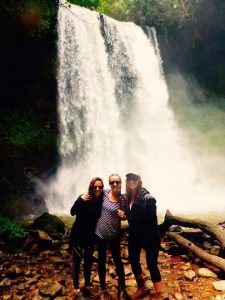
After breakfast the next morning, we headed off on our 18 kilometer trek. Luckily, the weather managed to stay dry for the whole day, as we hiked over tough terrain, steep hills and had some very slippy moments. Eventually we decided to just succumb to the mud and stop trying to stay clean and dry! We stopped at 3 waterfalls along the way, and at the first we jumped off the top of the waterfall into the cold water and hung from the tree branches. The second waterfall was enormous and soaked us in spray, and at the third waterfall, we trekked behind it into a cave where we sat to eat our lunch of rice and vegetables. As we continued on, Leung pointed out different kinds of plants, flowers, frogs, insects, and various mushroom breeds.
Finally, around 8 hours after we took off, we arrived in Leung’s village, exhausted and muddy, but beaming with pride. (Leung told us he does this trek 4 times per week!) He introduced us to his family (he has 8 brothers and sisters, which is quite common among the 43 families who live in this village), and his family have several pigs and lots of piglets, chickens, cows and buffalo. There were some young children playing football just down the path, everybody stopped to say hello to us and offered us rice wine. Leung told us that they all rear animals and share the meat among the families. He said that whilst he has his immediate family (who all live in a small wooden house, with an old retro caravan attached!), he feels as though the whole village is his family, as they have all grown up together.
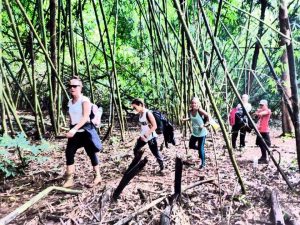
When it came time to say goodbye to Leung and the village, it seemed strange after such a meaningful and intense 24 hours getting to know him. While we all trickled back to our office jobs and city life, Leung would stay on the edge of the jungle in his hill tribe village, perfectly content to guide more jungle trekkers. Although we loved the elephants, and the trekking and the camping experience was so much fun, I would recommend this trip simply for the experience of meeting Leung, an uncomplicated 21 year old guy, with so much love for the jungle and keen to share his devotion to his beautiful home and people.


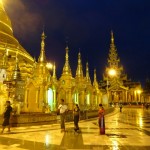
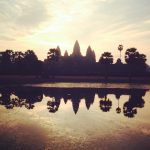
Excellent! Keep it up.
Thank you so much for putting this together! I am currently looking into planning my Cambodia trip and your post was super insightful! 🙂